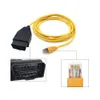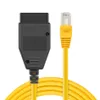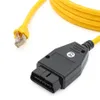ENET Cable: Enhancing Diagnostics for BMW F-Series Vehicles







Understanding the ENET Cable
For car enthusiasts and professionals alike, the ENET cable has become a staple tool in diagnostic procedures for BMW F-Series vehicles. The ENET cable is a specialized Ethernet cable that connects a laptop or computer to a car’s OBD-II port, allowing for diagnostics and coding of various vehicle systems. In this article, we will explore the features and capabilities of the ENET cable and how it enhances diagnostic procedures for BMW F-Series vehicles.
A. Explanation of Features and Capabilities of the ENET Cable
The ENET cable is a specialized Ethernet cable that is designed with a unique purpose – to connect a laptop or computer to a car’s OBD-II port for diagnostics and coding. One of the key features of the ENET cable is its compatibility with BMW F-Series vehicles, which enables users to access a variety of systems and modules within the car. These systems include engine control units, transmission control units, airbag modules, and more.
Another feature of the ENET cable is its ability to communicate with the car’s systems at a high-speed rate, allowing for faster and more accurate diagnostics. Additionally, the ENET cable comes equipped with specialized software, such as BMW Standard Tools and ISTA-D, which are necessary for performing advanced diagnostics and coding procedures.
B. Description of How the ENET Cable Enhances Diagnostic Procedures for BMW F-Series Vehicles
One of the most significant benefits of using the ENET cable for BMW F-Series diagnosis is its ability to provide users with access to a vast array of vehicle systems and modules. With this level of access, users are able to perform detailed diagnostics and coding procedures that were once only possible through expensive dealership equipment.
The ENET cable also provides users with real-time data and fault code readouts, enabling them to quickly identify and diagnose issues within the car. This level of accuracy and speed can save time and money on repairs, as well as improve overall vehicle performance.
Moreover, the ENET cable allows for customization and coding procedures that enhance the driving experience. For example, users can tailor their car’s settings to their personal preferences, such as adjusting the lighting, audio, and seat settings. Additionally, the ENET cable allows users to perform software updates and modifications to the car’s systems, improving overall functionality and performance.
Benefits of using the ENET Cable
One of the primary advantages of utilizing an ENET cable is the improved accuracy and precision in data transfer. Compared to other diagnostic tools that rely on Bluetooth or Wi-Fi connectivity, the ENET cable establishes a direct connection between the vehicle’s ECU and the computer. This means that there is less room for errors and inconsistencies in data transfer, resulting in more accurate readings and diagnoses.
Another benefit of using an ENET cable is its compatibility with a wide range of BMW F-Series vehicles. Unlike traditional diagnostic tools that may only work with specific models or years, the ENET cable can be used across a variety of F-Series vehicles. This versatility not only saves time and money but also allows for greater flexibility in diagnosing and repairing issues across different BMW models.
Finally, perhaps one of the most appealing aspects of using an ENET cable is its cost-effectiveness compared to traditional diagnostic tools. While other tools may require expensive subscriptions or updates, the ENET cable typically requires only a one-time purchase and software installation. Furthermore, as previously mentioned, its compatibility across multiple BMW models means that it can eliminate the need for purchasing separate diagnostic tools for each vehicle.
How to use the ENET Cable
The ENET cable is a diagnostic tool that can be used to access and modify the software of BMW F-Series vehicles. It allows users to perform advanced coding, programming, and diagnostics on their BMWs. In this guide, we will provide a step-by-step guide on how to connect the ENET cable to your BMW F-Series vehicle, as well as tips for maximizing its effectiveness during diagnostics.
Step-by-Step Guide on Connecting the ENET Cable to BMW F-Series Vehicles
Before you begin, make sure that you have the following:
– A laptop or PC running Windows 7 or newer
– The latest version of the BMW coding software (e.g., E-Sys)
– An ENET cable (preferably one with an Ethernet switch)
1. Start by turning on your Windows computer and launching the BMW coding software. Make sure that the software is up to date and that you have installed any necessary updates.
2. Next, connect the ENET cable to your BMW’s OBD-II port, which is usually located under the dashboard on the driver’s side. The OBD-II port is a small, rectangular connector with pins inside.
3. Connect the other end of the ENET cable to your computer’s Ethernet port. If your computer does not have an Ethernet port, you can use a USB-to-Ethernet adapter.
4. Now, start your BMW’s engine and wait for it to idle. This will ensure that the battery is supplying enough power to run the coding process.
5. Launch the BMW coding software and select your BMW’s model and year from the dropdown menus. You should also select “ENET” as the interface type.
6. Once you have selected your BMW’s model and year, you will be prompted to enter the VIN number. This is a unique 17-digit code that identifies your BMW. You can find it on your car’s registration or insurance documents.
7. After entering the VIN number, you can start the coding process. This may take several minutes, depending on the complexity of the coding changes you are making. Be patient and do not disconnect the ENET cable while the coding process is in progress.
Tips for Maximizing the Effectiveness of the ENET Cable During Diagnostics
Now that you know how to connect the ENET cable to your BMW, let’s explore some tips that can help you get the most out of this diagnostic tool.
1. Keep the ENET cable clean and dry. Moisture and dirt can interfere with the connection and cause data transfer errors.
2. Use high-quality ENET cables with Ethernet switches. These cables provide better stability and speed, which can make the coding process faster and more reliable.
3. Always follow the instructions provided by the BMW coding software. This software has been designed specifically for BMWs and knows how to communicate with your vehicle’s onboard computer system.
4. Back up your original coding before making any changes. This will allow you to revert to the original settings if something goes wrong during the coding process.
5. Read forums and online resources to learn more about advanced coding techniques and common coding errors. This can help you avoid making mistakes and improve your overall coding skills.
In conclusion, the ENET cable is a powerful diagnostic tool that can help BMW F-Series vehicle owners diagnose and troubleshoot problems with their cars. By following the step-by-step guide above and using the tips provided, you can unlock the full potential of this tool and take your BMW coding skills to the next level.
FAQ
Q1. What is an ENET cable and how does it enhance diagnostics for BMW F-Series vehicles?
The ENET cable is a specialized tool used for data transfer and diagnostics in BMW F-Series vehicles. It allows for precise and efficient communication between the vehicle’s onboard systems and diagnostic equipment, enabling technicians to accurately identify and address any issues with the vehicle’s performance.
Q2. What makes the ENET cable a preferred choice for BMW F-Series vehicles?
The ENET cable is specifically designed to be compatible with BMW F-Series vehicles, offering a seamless connection for diagnostic purposes. Its advanced technology ensures fast and reliable data transfer, allowing for real-time analysis of the vehicle’s systems and components. Additionally, the cable is durable and easy to use, making it a preferred choice for professional technicians and DIY enthusiasts alike.
Q3. Can the ENET cable be used for programming and coding in BMW F-Series vehicles?
Yes, the ENET cable is not only limited to diagnostics but can also be used for programming and coding in BMW F-Series vehicles. This includes updating software, configuring new features, and customizing settings to meet specific preferences. With its wide compatibility and precise data transfer capabilities, the ENET cable provides a comprehensive solution for all diagnostic and programming needs in BMW F-Series vehicles.
Q4. How can I ensure that the ENET cable is properly configured and utilized for my BMW F-Series vehicle?
To ensure optimal performance and compatibility, it is important to use a high-quality ENET cable that is specifically designed for use with BMW F-Series vehicles. Additionally, it is recommended to follow the manufacturer’s guidelines for installation and usage, as well as to regularly update the diagnostic software to ensure seamless integration with the ENET cable. By doing so, you can maximize the efficiency and accuracy of diagnostics, programming, and coding processes for your BMW F-Series vehicle.